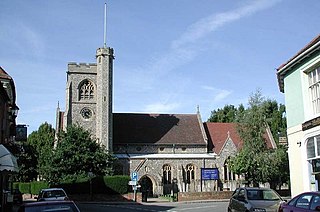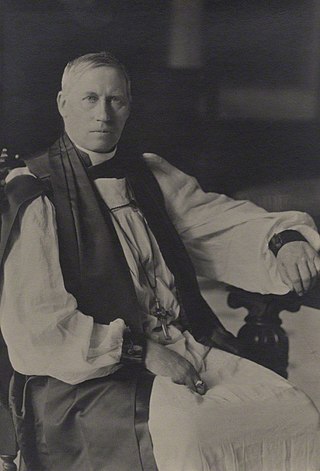Related Research Articles

Hatfield is a town and civil parish in Hertfordshire, England, in the borough of Welwyn Hatfield. It had a population of 29,616 in 2001, 39,201 at the 2011 Census, and 41,265 at the 2021 Census. The settlement is of Saxon origin. Hatfield House, home of the Marquess of Salisbury, forms the nucleus of the old town. From the 1930s when de Havilland opened a factory until the 1990s when British Aerospace closed it, aircraft design and manufacture employed more people there than any other industry. Hatfield was one of the post-war New Towns built around London and has much modernist architecture from the period. The University of Hertfordshire is based there.

Jerry Eugene Pournelle was an American scientist in the area of operations research and human factors research, a science fiction writer, essayist, journalist, and one of the first bloggers. In the 1960s and early 1970s, he worked in the aerospace industry, but eventually focused on his writing career. In an obituary in Gizmodo, he is described as "a tireless ambassador for the future."

Martin Van Buren was an American lawyer and statesman who served as the eighth president of the United States from 1837 to 1841. A primary founder of the Democratic Party, he served as New York's attorney general, U.S. senator, then briefly as the ninth governor of New York before joining Andrew Jackson's administration as the tenth United States secretary of state, minister to the United Kingdom, and ultimately the eighth vice president of the United States when named Jackson's running mate for the 1832 election. Van Buren won the presidency in 1836, lost re-election in 1840, and failed to win the Democratic nomination in 1844. Later in his life, Van Buren emerged as an elder statesman and an important anti-slavery leader who led the Free Soil Party ticket in the 1848 presidential election.

Lieutenant Colonel James David Graham Niven was a British actor, soldier, memoirist, and novelist. He won the Academy Award for Best Actor for his performance as Major Pollock in Separate Tables (1958). Niven's other roles included Squadron Leader Peter Carter in A Matter of Life and Death (1946), Phileas Fogg in Around the World in 80 Days (1956), Sir Charles Lytton in The Pink Panther (1963), James Bond in Casino Royale (1967), and Colonel Race in Death on the Nile (1978).

Welwyn Garden City is a town in Hertfordshire, England, 20 miles (32 km) north of London. It was the second garden city in England and one of the first new towns. It is unique in being both a garden city and a new town and exemplifies the physical, social and cultural planning ideals of the periods in which it was built.

Welwyn is a village and civil parish in Hertfordshire, England. The parish also includes the villages of Digswell and Oaklands. It is sometimes referred to as Old Welwyn or Welwyn Village, to distinguish it from the much newer and larger settlement of Welwyn Garden City, about a mile to the south.

The Popish Plot was a fictitious conspiracy invented by Titus Oates that between 1678 and 1681 gripped the kingdoms of England and Scotland in anti-Catholic hysteria. Oates alleged that there was an extensive Catholic conspiracy to assassinate Charles II, accusations that led to the executions of at least 22 men and precipitated the Exclusion Bill Crisis. Eventually, Oates's intricate web of accusations fell apart, leading to his arrest and conviction for perjury.

Ayot St Lawrence is a small English village and civil parish in Hertfordshire, two miles west of Welwyn. There are several other Ayots in the area, including Ayot Green and Ayot St Peter, where the census population of Ayot St Lawrence was included in 2011.

Philander Chase was an Episcopal Church bishop, educator, and pioneer of the United States western frontier, especially in Ohio and Illinois.

The Episcopal Diocese of Ohio is a diocese of the Episcopal Church in the United States of America comprising the northern 48 counties of the state of Ohio. Established in 1818, it was the first diocese of the Episcopal Church to be established outside the original 13 colonies and presently consists of 95 parishes, with a membership of almost 19,000 individuals. The diocese was contiguous with the state of Ohio, but was divided into two dioceses in 1875, due to the geographical size of the diocese and the poor health of Bishops MacIlvaine and Bedell. The Episcopal Diocese of Ohio, which retained the original name, and the Diocese of Southern Ohio headquartered in Cincinnati. It is one of 15 dioceses that make up the Province of the Midwest.

Woolmer Green is a small village and civil parish in Hertfordshire, England. The 2011 census figure for the population is 661 people.

Finmere is a village and civil parish in Oxfordshire, south of the River Great Ouse. It is on the county boundary with Buckinghamshire, almost 4 miles (6 km) west of Buckingham and just over 4 miles (6 km) east of Brackley in Northamptonshire. The 2011 Census recorded the parish's population as 466.

Ruthin School is a public school located on the outskirts of Ruthin, the county town of Denbighshire, North Wales. It is over seven hundred years old, making it one of the oldest schools in the United Kingdom. Originally a school for boys, it has been co-educational since 1990.

Arthur Cayley Headlam was an English theologian who served as Bishop of Gloucester from 1923 to 1945.

Raffles is a 1939 American crime comedy film starring David Niven and Olivia de Havilland, and is one of several film adaptations of an 1899 short story collection by E. W. Hornung, The Amateur Cracksman.

Alan Peter Winton is the Bishop of Thetford in the Church of England Diocese of Norwich.

Digswell House is a Grade II listed Mansion in Hertfordshire, erected c. 1805–07 by Samuel Wyatt for the Honourable Edward Spencer Cowper, who lived there for some years. It was built in the parish of Digswell from which it takes its name, but was transferred to Welwyn Garden City in 1921. The house is now in the Knightsfield area of Welwyn Garden City. The current house was erected a little eastward of the site on which its predecessor had stood and was built as a commodious country gentleman's home, in an architectural style that can best be described as neoclassical. A portico, with four massive Ionic columns, on the south front is its most impressive external feature.

Paul Kenyon is a BAFTA-winning journalist and author who has reported from conflict zones around the world for BBC Panorama and has written several books. He made his name confronting criminals in his own prime time TV show on BBC 1.
Donald MacAdie was a suffragan bishop of the Episcopal Diocese of Newark, serving from 1958 to 1963.

James Pernette deWolfe was the fourth bishop of the Episcopal Diocese of Long Island.
References
- ↑ Metroland course notes, Twentieth Century Society, 2008